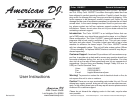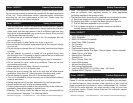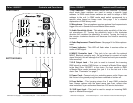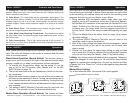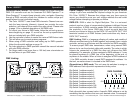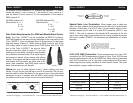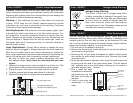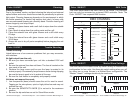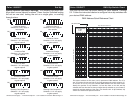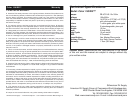
©American DJ Supply® - www.americandj.com - Color 150/RG™ Instruction Manual Page 12©American DJ Supply® - www.americandj.com - Color 150/RG™ Instruction Manual Page 11
Data Cable Requirements (For DMX and Master/Slave Opera-
tion): The Color 150/RG™ can be controlled via DMX-512 protocol.
The DMX address is set using the dip-switches on the rear panel of the
Color 150/RG™. Your unit excepts 3-pin XLR connector for data input
and data output (Figure 5). When using a DMX controller with 5-Pin
XLR output jacks or when linking from a DMX fi xture with 5-Pin XLR
jack to the Color 150/RG™, be sure to follow
the pin conversion chart on page 12. If you are
making your own cables, be sure to use standard
two conductor shielded cable (This cable may be
purchased at almost all pro sound and lighting
stores). Your cables should be made with a male
and female XLR connector on either end of the
cable. Also remember that DMX cable must be
daisy chained and can not be split.
Figure 5
Color 150/RG™ Set Up
Figure 6
1 Ground
1 Ground
XLR Male Socket
XLR Pin Confi guration
3 Hot
2 Cold
2 Cold
3 Hot
XLR Female Socket
Pin 3 = Data True (positive)
Pin 2 = Data Compliment (negative)
Pin 1 = Ground
Color 150/RG™ Set Up
Notice: Be sure to follow fi gures 6 and 7 when making your own
cables. Do not use the ground lug on the XLR connector. Do not con-
nect the cable’s shield conductor to the ground lug or allow the shield
conductor to come in contact with the XLR’s outer casing. Grounding
the shield could cause a short circuit and erratic behavior.
DMX512 IN
3-PIN XLR
1
2
3
1
2
3
DMX +
DMX -
COMMON
DMX512 OUT
3-PIN XLR
Figure 7
Special Note: Line Termination.
When longer runs of cable are
used, you may need to use a terminator on the last unit to avoid erratic
behavior. A terminator is a 90-120 ohm 1/4 watt resistor which is con-
nected between pins 2 and 3 of a male XLR connector (DATA + and
DATA -). This unit is inserted in the female XLR connector of the last
unit in your daisy chain to terminate the line. Using a cable terminator
(ADJ part number ZDMX/T) will decrease the possibilities of erratic
behavior.
1
2
3
Termination reduces signal errors and
avoids signal transmission problems
and interference. It is always advisable
to connect a DMX terminal, (Resistance
120 Ohm 1/4 W) between PIN 2 (DMX-)
and PIN 3 (DMX +) of the last fixture.
Figure 8
To achieve a DMX address of 21, combine dip switches 1, 3, and 5.
Sense dip switch 1 has a value of 1, dip switch 3 has a value of 4,
and dip switch 5 has a value of 16, the combination of the create a
DMX value of 21.
Set DMX address 21: Set DMX address 201:
Dip-switches # 1 = 1 Dip-switches # 1 = 1
3 = 4 4 = 8
5 = 16 7 = 64
= 21 8 = 128
= 201
5-Pin XLR DMX Connectors.
Some manufactures use 5-pin XLR
connectors for DATA transmission in place of 3-pin. 5-pin XLR fi xtures
may be implemented in a 3-pin XLR DMX line. When inserting standard
5-pin XLR connectors in to a 3-pin line a cable adaptor must be used,
these adaptors are readily available at most electric stores. The chart
below details a proper cable conversion.
Conductor 5-Pin XLR Male (In)3-Pin XLR Female (Out)
Pin 1
Do Not Use
Do Not Use
Pin 3
Pin 2
Pin 1
Pin 3
Pin 2
Not Used
Not Used
Data True (+ signal)
Data Compliment (- signal)
Ground/Shield
3-Pin XLR to 5-Pin XLR Conversion



